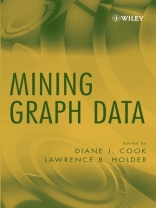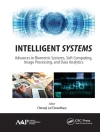This text takes a focused and comprehensive look at mining data represented as a graph, with the latest findings and applications in both theory and practice provided. Even if you have minimal background in analyzing graph data, with this book you’ll be able to represent data as graphs, extract patterns and concepts from the data, and apply the methodologies presented in the text to real datasets.
There is a misprint with the link to the accompanying Web page for this book. For those readers who would like to experiment with the techniques found in this book or test their own ideas on graph data, the Web page for the book should be http://www.eecs.wsu.edu/MGD.
Table des matières
Preface.
Acknowledgments.
Contributors.
1 INTRODUCTION (Lawrence B. Holder and Diane J. Cook).
1.1 Terminology.
1.2 Graph Databases.
1.3 Book Overview.
References.
Part I GRAPHS.
2 GRAPH MATCHING—EXACT AND ERROR-TOLERANT METHODS AND THE AUTOMATIC LEARNING OF EDIT COSTS (Horst Bunke and Michel Neuhaus).
2.1 Introduction.
2.2 Definitions and Graph Matching Methods.
2.3 Learning Edit Costs.
2.4 Experimental Evaluation.
2.5 Discussion and Conclusions.
References.
3 GRAPH VISUALIZATION AND DATA MINING (Walter Didimo and Giuseppe Liotta).
3.1 Introduction.
3.2 Graph Drawing Techniques.
3.3 Examples of Visualization Systems.
3.4 Conclusions.
References.
4 GRAPH PATTERNS AND THE R-MAT GENERATOR (Deepayan Chakrabarti and Christos Faloutsos).
4.1 Introduction.
4.2 Background and Related Work.
4.3 Net Mine and R-MAT.
4.4 Experiments.
4.5 Conclusions.
References.
Part II MINING TECHNIQUES.
5 DISCOVERY OF FREQUENT SUBSTRUCTURES (Xifeng Yan and Jiawei Han).
5.1 Introduction.
5.2 Preliminary Concepts.
5.3 Apriori-based Approach.
5.4 Pattern Growth Approach.
5.5 Variant Substructure Patterns.
5.6 Experiments and Performance Study.
5.7 Conclusions.
References.
6 FINDING TOPOLOGICAL FREQUENT PATTERNS FROM GRAPH DATASETS (Michihiro Kuramochi and George Karypis).
6.1 Introduction.
6.2 Background Definitions and Notation.
6.3 Frequent Pattern Discovery from Graph Datasets—Problem Definitions.
6.4 FSG for the Graph-Transaction Setting.
6.5 SIGRAM for the Single-Graph Setting.
6.6 GREW—Scalable Frequent Subgraph Discovery Algorithm.
6.7 Related Research.
6.8 Conclusions.
References.
7 UNSUPERVISED AND SUPERVISED PATTERN LEARNING IN GRAPH DATA (Diane J. Cook, Lawrence B. Holder, and Nikhil Ketkar).
7.1 Introduction.
7.2 Mining Graph Data Using Subdue.
7.3 Comparison to Other Graph-Based Mining Algorithms.
7.4 Comparison to Frequent Substructure Mining Approaches.
7.5 Comparison to ILP Approaches.
7.6 Conclusions.
References.
8 GRAPH GRAMMAR LEARNING (Istvan Jonyer).
8.1 Introduction.
8.2 Related Work.
8.3 Graph Grammar Learning.
8.4 Empirical Evaluation.
8.5 Conclusion.
References.
9 CONSTRUCTING DECISION TREE BASED ON CHUNKINGLESS GRAPH-BASED INDUCTION (Kouzou Ohara, Phu Chien Nguyen, Akira Mogi, Hiroshi Motoda, and Takashi Washio).
9.1 Introduction.
9.2 Graph-Based Induction Revisited.
9.3 Problem Caused by Chunking in B-GBI.
9.4 Chunkingless Graph-Based Induction (Cl-GBI).
9.5 Decision Tree Chunkingless Graph-Based Induction (DT-Cl GBI).
9.6 Conclusions.
References.
10 SOME LINKS BETWEEN FORMAL CONCEPT ANALYSIS AND GRAPH MINING (Michel Liquière).
10.1 Presentation.
10.2 Basic Concepts and Notation.
10.3 Formal Concept Analysis.
10.4 Extension Lattice and Description Lattice Give Concept Lattice.
10.5 Graph Description and Galois Lattice.
10.6 Graph Mining and Formal Propositionalization.
10.7 Conclusion.
References.
11 KERNEL METHODS FOR GRAPHS (Thomas Gärtner, Tamás Horváth, Quoc V. Le, Alex J. Smola, and Stefan Wrobel).
11.1 Introduction.
11.2 Graph Classification.
11.3 Vertex Classification.
11.4 Conclusions and Future Work.
References.
12 KERNELS AS LINK ANALYSIS MEASURES (Masashi Shimbo and Takahiko Ito).
12.1 Introduction.
12.2 Preliminaries.
12.3 Kernel-based Unified Framework for Importance and Relatedness.
12.4 Laplacian Kernels as a Relatedness Measure.
12.5 Practical Issues.
12.6 Related Work.
12.7 Evaluation with Bibliographic Citation Data.
12.8 Summary.
References.
13 ENTITY RESOLUTION IN GRAPHS (Indrajit Bhattacharya and Lise Getoor).
13.1 Introduction.
13.2 Related Work.
13.3 Motivating Example for Graph-Based Entity Resolution.
13.4 Graph-Based Entity Resolution: Problem Formulation.
13.5 Similarity Measures for Entity Resolution.
13.6 Graph-Based Clustering for Entity Resolution.
13.7 Experimental Evaluation.
13.8 Conclusion.
References.
Part III APPLICATIONS.
14 MINING FROM CHEMICAL GRAPHS (Takashi Okada).
14.1 Introduction and Representation of Molecules.
14.2 Issues for Mining.
14.3 CASE: A Prototype Mining System in Chemistry.
14.4 Quantitative Estimation Using Graph Mining.
14.5 Extension of Linear Fragments to Graphs.
14.6 Combination of Conditions.
14.7 Concluding Remarks.
References.
15 UNIFIED APPROACH TO ROOTED TREE MINING: ALGORITHMS AND APPLICATIONS (Mohammed Zaki).
15.1 Introduction.
15.2 Preliminaries.
15.3 Related Work.
15.4 Generating Candidate Subtrees.
15.5 Frequency Computation.
15.6 Counting Distinct Occurrences.
15.7 The SLEUTH Algorithm.
15.8 Experimental Results.
15.9 Tree Mining Applications in Bioinformatics.
15.10 Conclusions.
References.
16 DENSE SUBGRAPH EXTRACTION (Andrew Tomkins and Ravi Kumar).
16.1 Introduction.
16.2 Related Work.
16.3 Finding the densest subgraph.
16.4 Trawling.
16.5 Graph Shingling.
16.6 Connection Subgraphs.
16.7 Conclusions.
References.
17 SOCIAL NETWORK ANALYSIS (Sherry E. Marcus, Melanie Moy, and Thayne Coffman).
17.1 Introduction.
17.2 Social Network Analysis.
17.3 Group Detection.
17.4 Terrorist Modus Operandi Detection System.
17.5 Computational Experiments.
17.6 Conclusion.
References.
Index.
A propos de l’auteur
DIANE J. COOK, Ph D, is the Huie-Rogers Chair Professor in the School of Electrical Engineering and Computer Science at Washington State University. Her extensive research in artificial intelligence and data mining has been supported by grants from the National Science Foundation, NASA, DARPA, and Texas Instruments. Dr. Cook is the coauthor of
Smart Environments: Technology, Protocols, and Applications (Wiley).
LAWRENCE B. HOLDER, Ph D, is Professor in the School of Electrical Engineering and Computer Science at Washington State University, where he teaches and conducts research in artificial intelligence, machine learning, data mining, graph theory, parallel and distributed processing, and cognitive architectures.












